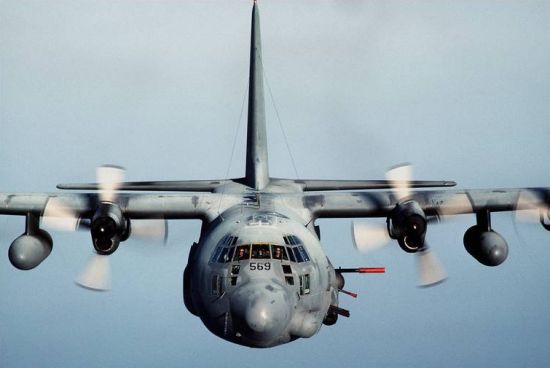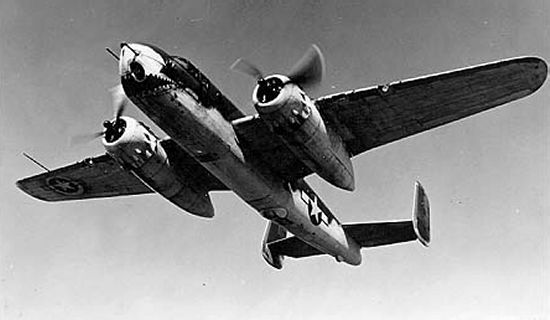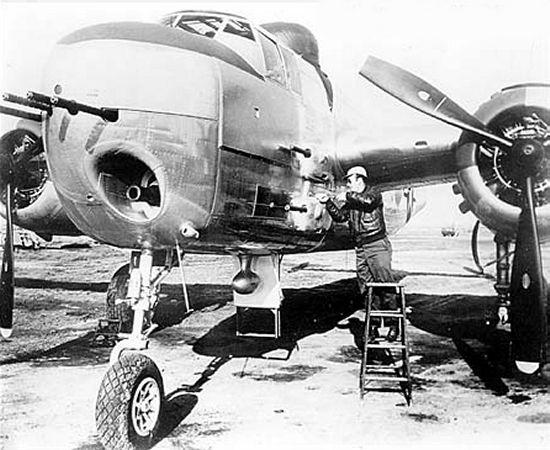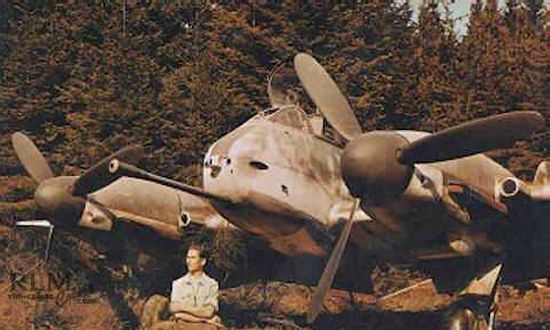|
||||||||||
|
|
||||||||||
|
||||||||||
|
|
||||||||||
AC-130: 105-mm
I believe the single largest gun ever mounted aboard an airplane is the 105-mm M102 Howitzer cannon fitted to the AC-130 gunship variant of the C-130 Hercules transport plane.

The M102 was originally developed as a light towed artillery piece for the US Army and was used extensively during the Vietnam War and Operation Desert Storm. Though the M102 has been replaced by the M119A1 in front-line Army units, the same basic cannon and recoil system has been used in the AC-130 since the early 1970s.

The gun is mounted towards the aft end of the aircraft and is fired through a large door in the left side of the fuselage. The AC-130 usually carries 96 rounds of ammunition for the massive gun, and the maximum rate of fire is between six and ten rounds per minute. Weighing around 3,000 lb (1,360 kg), the Howitzer is usually operated by a crew of two to four gunners.
Piaggio P.108A: 105-mm
The Piaggio P.108 was a large four-engine bomber built in small numbers by Italy during World War II. A P.108A was also fitted with a 105-mm cannon, but only tested experimentally. The new design never made it into production and never saw service.

B-25G/H Mitchell: 75-mm
The B-25 Mitchell was an American medium bomber used both in Europe and the Pacific during World War II. In 1942, work began on modifying a B-25 to carry a new 75-mm M4 cannon, based on the French 75 used during World War I. This new aircraft was given the designation B-25G, and the design featured a number of modifications to the nose to carry the 75-mm cannon. The 9.5 ft (2.9 m) long cannon weighed 905 lb (410 kg) and was located in a cradle in the lower left-hand side of the nose, as pictured below. Located just above the cannon were two 0.50-inch caliber machine guns. Further modifications to the basic B-25 included addition of a spring mechanism and structural strengthening to handle the 21-inch recoil of the M4 cannon. The G model was also equipped with more extensive armor plating given its role as a ground attack and strafing platform.

The cannon was loaded and fired manually by a single crewman, the task being delegated to the navigator/cannoneer. Each 75-mm shell weighed 15 lb (6.8 kg), and a total of 21 rounds were carried. About 400 examples of the B-25G were built either as new production aircraft or modified from B-25C airframes. The aircraft saw extensive service in the south Pacific where they had great success against anti-aircraft batteries and Japanese shipping. The type also saw limited action in the Mediterranean.

The B-25H was an improved version of the B-25G. The M4 cannon was replaced by a lighter T13E1 75-mm cannon, and several more 0.50-inch caliber machine guns were added to the nose and pods mounted along the fuselage. Some 1,000 examples of the B-25H were built, primarily for the Pacific theater.
Mosquito Mk XVIII: 57-mm
The Mosquito was one of Great Britain's most successful attack fighters of World War II. The type was built in several variants, including the FB.XVIII fighter bomber. Also known as the "Tse Tse Fly," this particular model was armed with four 0.303-inch caliber machine guns and a single 57-mm cannon in the nose. The 57-mm cannon was based on a standard Army light artillery piece called the 6-pounder but modified with a Molins automatic loader. The entire system weighed about 1,800 lb (815 kg). The aircraft carried 25 rounds of ammunition, weighing 7 lb (3.2 kg) each, and the automatic loader could fire the entire magazine in just 20 seconds.

The aircraft was originally designed as an anti-tank weapon, but was instead used for anti-shipping and anti-submarine duties as well as to attack shore installations. However, rockets were found to be better suited to the task, so the cannon was later supplemented by an armament of two 500-lb bombs or eight 60-lb rockets. Only 27 examples were built, the first seeing action in October of 1943.
Me 410 Hornisse: 50-mm
The German Me 410 Hornisse (Hornet) was developed as a fighter bomber replacement for the Bf-110 and Me 210. The Me 410A-1/U4 was a dedicated bomber destroyer version with all of the nose armaments removed in favor of a single 50-mm BK 5 cannon taking up part of the bomb bay. The gun was based on the PAK 38 anti-tank gun used by the German Army. Fed by a 21 round cylindrical magazine, the cannon was aimed using a ZFR 4a telescopic sight located in the nose just above the gun itself. The BK 5 cannon weighed 1,190 lb (540 kg) and could fire up to 50 rounds per minute.

The Me 410A-2/U4 was an improved variant retaining the standard nose armament in addition to the 50-mm cannon. A total of 1,600 Me 410s were built, but it is unknown how many were of the A-1/U4 and A-2/U4 standards. The type began entering service in 1943.
Hurricane Mk IID and IV: 40-mm
Another British fighter that saw extensive action during World War II was the Hawker Hurricane. Later variants included the Hawker Mk IID equipped with two 40-mm Vickers Type S cannons in addition to two Browning 0.303-inch machine guns. The 40-mm cannons had originally been developed during the 1930s as defensive armament for British bombers. However, the gun was later adopted for use in anti-tank and ground attack missions. The gun could carry either armor piercing rounds for anti-tank attacks or high explosive rounds for other ground attack duties. Weighing 295 lb (135 kg), the Vickers S gun could fire its magazine of 15 rounds, weighing 2.5 lb (1.13 kg) each, at a rate of 100 rounds per minute. The 40-mm cannons were carried one under each of the Hurricane's wing.

The Hurricane IID first saw action in North Africa beginning in mid-1942. The type achieved considerable success by striking 144 enemy tanks, of which 47 were destroyed, as well as 200 other vehicles. Losses to ground fire were severe given the Hurricane's lack of armor protection, but the type also saw success in southeast Asia using high explosive shells to attack Japanese transportation routes. An improved model was the Hurricane Mk IV carrying the same armament as the Mk IID but also capable of carrying two 500-lb bombs or up to eight rockets.
AC-130: 40-mm
In addition to the 105-mm Howitzer described above, the AC-130 is also fitted with a single 40-mm L60 Bofors cannon (early AC-130s carried two 40-mm and no 105-mm guns). The L60 cannon was originally developed by Sweden during the early 1930s for use as an anti-aircraft gun. The weapon proved so popular that it was adapted to a variety of roles, including ship-based variants, and used by both Allied and Axis powers during World War II.

The variant carried aboard the C-130 fires an armor-piercing shell called the APFSDS, short for Armor Piercing Fin
Stabilized Discarding Sabot. The AC-130 carries about 256 rounds of ammunition, and the L60 cannon can fire shots
singly or at rates up to 120 rounds per minute.
- answer by Greg Alexander, 2 May 2004
Related Topics:
Read More Articles:


|
Aircraft | Design | Ask Us | Shop | Search |

|
|
| About Us | Contact Us | Copyright © 1997-2023 | |||
|
|
|||